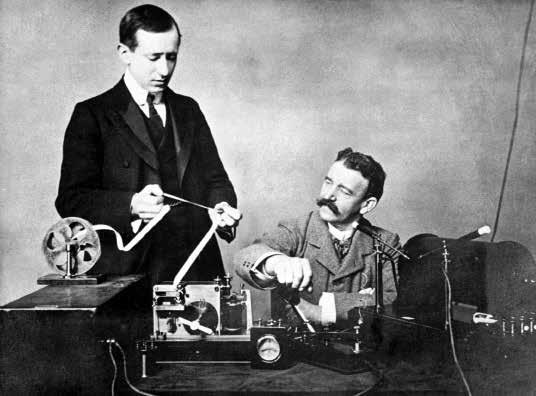




The twentieth century had not yet begun, and already humanity was ready to welcome it, investigate it, and immortalize it with a camera. The instrument was still young, and yet so pervasive and effective that it would change forever our way of experiencing and reporting history: both private history – of individuals and families of every social background, who could leave for posterity tangible evidence of their existence – and history with a capital “H,” which is inevitably marked by fewer but grander figures and events.
The history books relate that the history of photography began in 1839, when the prestigious Académie des Sciences de l’Institut de France and the Académie des Beaux-Arts recognized the new daguerreotype technique, invented by Louis Daguerre, a man of multifaceted brilliance. In reality the unofficial history had begun at least twelve years before, when Joseph Nicéphore Niépce obtained the first, unstable image “drawn with light.” He then began a close collaboration with Daguerre. As often happens with great inventions, there are many disputes and “counter-histories” regarding the invention of photography. For example, the French pair, Niépce-Daguerre, is often opposed to two British scientists, Thomas Wedgwood and William Henry Fox Talbot. What is certain is that the new technique originated in France and Britain in the first half of the nineteenth century and that, from then on, it crossed borders and continents with remarkable speed.
We can identify two dates as watersheds in the transition of photography as a pastime for the wealthy, or as an activity requiring technical skill and training, to its spreading everywhere. The first is 1867, with the founding of Aktiengesellschaft für Anilinfabrikation (or Agfa, as it was later
Steve McCurry, Afghan Girl, 1984 Sharbat Gula was only 12 years old when she met Steve McCurry in a refugee camp in Peshawar, in an Afghanistan enduring a bloody Soviet invasion. She was brave. She chose not to hide, not even behind a smile. She challenges the camera with a gaze which is magnetic and yet difficult to hold. Without saying a word, she told of her pain and the dignity of her people, who for thirty years have suffered too many wars and still seek peace.
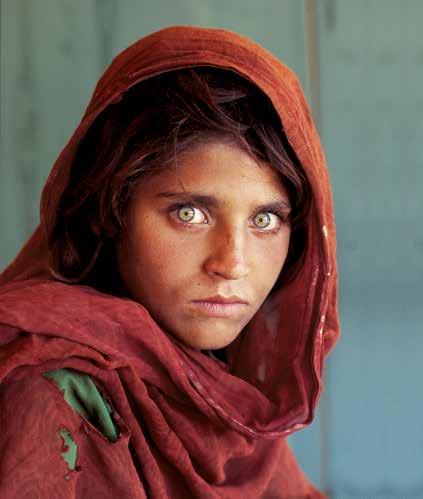

known) in Berlin, the company specialized in the production of photographic equipment. The second date is 1888, when the just-founded Kodak put on the market a small box camera that was relatively cheap and extremely simple to use: the model No. 1. From this moment on, there would always be a lens ready to immortalize practically every episode, every figure capable of making a more or less glorious, or at least significant, mark in the progress of humanity.
What started as an exciting phenomenon, at the beginning of the twentieth century, soon became an overwhelming rush. This revolution was completely unforeseen by those who, in the last decades of the nineteenth century, immortalized the opening of the Suez Canal, the building of the great railroads, and the construction of the Eiffel Tower over a Paris that was all optimism and Belle Époque elegance. It seemed that the fate of the planet could only be splendid and progressive, due to, above all, science and engineering. And photography, so modern and accessible, appeared to be more consistent with the fin-de-siècle Zeitgeist than painting and drawing, which for centuries had held a monopoly on the visual documentation of events. Photographs also seemed honest and sincere, and by their nature faithful to the reality of events: “It’s true! The camera can’t lie.” But soon we discovered that this is a shaky truth, and that photography can lie, too. And it was a still greater disappointment when we understood that the twentieth century had at least two faces. It was not only a crescendo of prodigious inventions and scientific discoveries (from telegraphic communication between Europe and America to the World Wide Web) and of social progress (from the battles for votes for women, to those for equality between whites and blacks, to the courage of Malala Yousafzai). Nor was it only an era of conquests, of challenges to the eternal snows of the poles, of reaching the stars. The latter began with the jerky flight of the Wright brothers, overcame accidents like that of the airship Hindenburg, only to reach ever higher, up to the mysterious red soil of Mars, where NASA has sent a rover that is able to communicate with Earth, and, of course, to take pictures. The twentieth century was also a dreadful sequence of wars, conducted on immense scales and with ever more deadly weapons: tools of
death which epitomize the dark side of progress. Chemical research laid the foundations for the use of asphyxiating gases in the First World War. Discoveries in physics were a step toward the use of atomic bombs in Japan. The great ideologies, as well, have required a tribute in blood. Only a few years after the taking of the Winter Palace, the Communist dream degenerated into the repression of every form of opposition, as the tanks advancing on Prague demonstrated. On the other hand, the so-called “export of democracy,” which drove the United States to invade Vietnam, had tragic consequences. And then there was the Berlin Wall, and the Cold War. More recently, we’ve seen genocide in Bosnia and Kosovo, September 11th, and the eternal drama of refugees.
We dedicate the volume you are reading to 100 photographs that document these and other key moments of the last century and a half. Thus it is not a history of photography, but a volume of photographs of history. Collected here are snapshots of events and figures who are very distant and different, and yet essential to form a picture of an era that was so full of promise and contradiction. They have often become icons, more effective than every other testimony, in a century marked by the power of the image over the written word. There are examples of manipulated or forged photographs, starting from the one portraying a famous speech by Lenin, which was “purged” by Stalin’s censorship; or of constructed photographs presented as reality, perhaps with good intentions, as in the shot that Major Tracy dedicated to the effects of asphyxiating gases.
Among the photographers selected are some giants, like Henri Cartier-Bresson, Robert Capa, Dorothea Lange and Cecil Beaton; great reporters and eye-witnesses with flair and courage, from Elliott Erwitt to Abbas Attar, from Eugene Smith to Kevin Carter, to Larry Burrows; directors from whose films frames with enormous symbolic force were taken, like the Lumière brothers and Sergej Ejzensˇtejn. But we owe many images to the honest artisans of photography and to amateurs, who sometimes remained nameless, and who had the good fortune to be in the right place at the right time, because history is not always predictable. The important thing, when it knocks on your door, is to have a camera in your hands, and to be ready to capture the moment.
May 10, 1869 - Promontory, Utah, United States
On May 10th, 1869, a large crowd waited at Promontory Summit, Utah, for the historic meeting between the locomotives Jupiter, of the Central Pacific line, and the 119, of the Union Pacific, which completed the first American transcontinental railroad (the only transcontinental line prior to this was the Panama Railway, but it was only 48 miles long). The two locomotives arrived and approached each other until the engineers managed to make them touch, then they shook hands and each broke a bottle of champagne on the locomotive of the other. A Golden Spike was driven with a silver hammer to symbolically weld together the rails of the two lines.
We owe this famous shot to Andrew J. Russell, a photographer who had already documented the American Civil War and had followed, in the previous years, the progress of the Transcontinental. In a composition typical of the commemorative photo, we see the workers framing the two locomotives and the handshake between the presidents of the two companies in the center of the shot.
Construction on the railroad linking the Atlantic and Pacific coasts was set in 1862, with the Pacific Railroad Act, signed by President Lincoln. It was entrusted to two companies, which would each have to complete part of the route until they met in the middle of the country.
Work began in the following year and went quickly despite innumerable difficulties, above all on the section which was to cross the mountains of the Sierra Nevada. To finance the construction, the companies received economic support and the ownership of a strip of land along the future railroad, which would soon gain a considerable market value. Central Pacific had many German, Irish, and Italian immigrants as workers, while most of the labor force for Union Pacific was Chinese.
The route envisaged crossing the hunting reserves of the Native American peoples. Feeling threatened by the invasion of their territories, they watched the advance of

the railroad and on various occasions they ambushed and violently attacked the workers.
“Done!” announced briefly a telegram from Leland Stanford, one of the financiers of Central Pacific, to President Grant, who had just begun his first term in office, to inform him of the success of the endeavor.
The completion of the railroad enabled people to accomplish in only seven days a journey that until then had required weeks, if not months, by stagecoach or by sea. Furthermore, it opened the territories of the West to massive colonization, which also led to the end of Native American civilization.
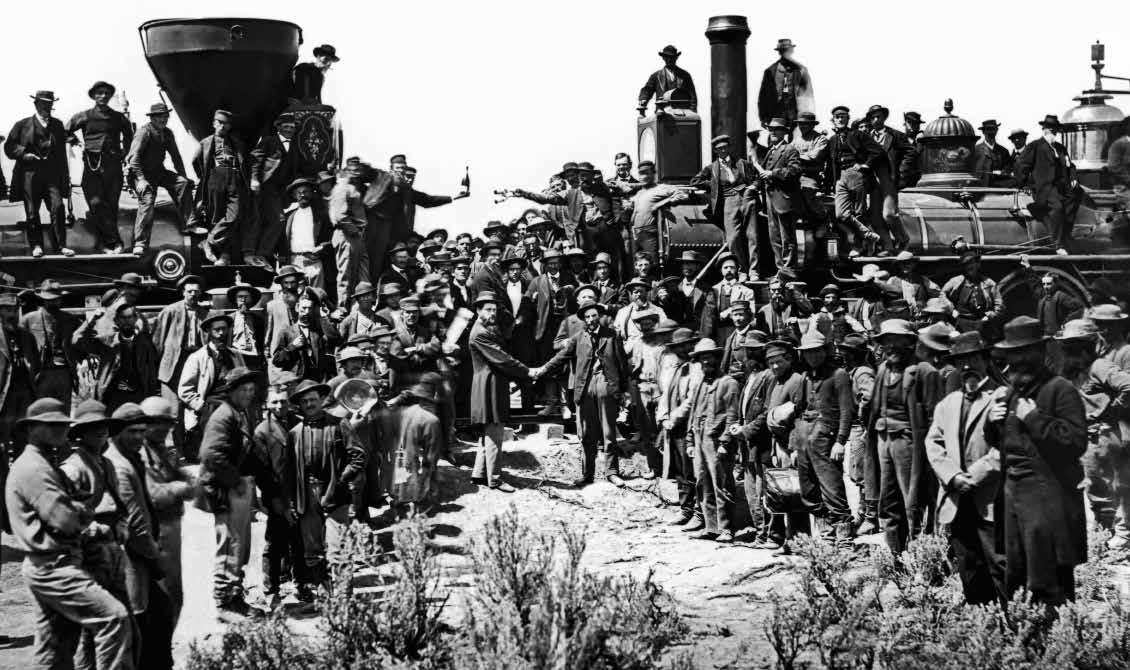

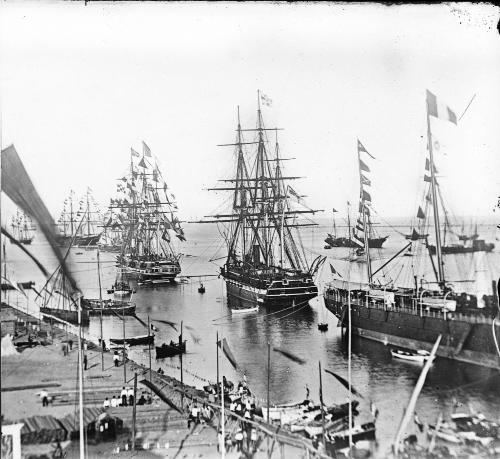
November 17, 1869 - Egypt
1869. Following the inauguration of the greatest work of hydraulic engineering ever completed, an artificial canal linked two oceans. The Suez Canal, constructed between the Red Sea and the Mediterranean, in fact connected the Indian Ocean to the Atlantic.
Europe and Asia were closer, at least for sea routes: there was no more need to circumnavigate Africa, saving days and days of travel. Ever since ancient times it had been a fabled enterprise, which even Napoleon had abandoned.
Photographic technology at the time was quite laborious: film, as we know it, hadn’t been invented yet. Photographers used negatives on glass with an emulsion of albumen (derived from egg white) and silver halide.
To immortalize the event, the unknown photographer of this image thus carried a heavy tripod onto a raised position, a terrace or scaffolding. In this way, he succeeded in photographing the procession of vessels dressed with flags entering the canal on November 17th, in the presence of the Empress Eugénie, the last female sovereign of France, and the Khedive of Egypt, Isma’il Pascià. An orchestra performed the Egyptischer-Marsch, which Johann Strauss, Jr. had composed for the occasion. The image precisely conveys the ships’ complex masts, reflections in the water, and the workers busy on the quays; it has the power to transport us into the heart of the event, with an immediacy that no illustration could achieve.
In 1889, Paris is the center of the world. Belle Époque elegance intensifies the secular rite of the World’s Fair, a hymn to progress and, for France, a celebration of the hundredth anniversary of the Revolution. For the occasion, an engineer with a revolutionary’s soul, Gustave Eiffel, has designed a tower destined to change the history of the city and of architecture. Some people already love it, while most still have to get used to its presence. They need time to take in a structure that is so huge and bulky, but at the same time innovative. Perhaps the Eiffel Tower has gone up too quickly: only two years, two months, and five days have elapsed between the opening of the construction site and the tower’s inauguration, on March 31st, 1889. When work on the tower begins, Henri Roger-Viollet is still in his teens. Born in 1869, he studies engineering, and loves photography. He enjoys creating photomontages before these are commonplace, often changing the proportions of the objects and the people he portrays. No one more than Roger-Viollet – with his young mind, engineering training, and creative spirit – can appreciate Eiffel’s genius. With his camera, he documents every phase of the construction, which rises day after day, from the first to the 324th meter (986th foot). Yet in this shot Roger-Viollet chooses not to pay homage to the verticality of the structure. He concentrates on its enormous base, which frames the Central Dome, the heart of the fair. The contrast of forms, and especially dimensions, between the powerful architectonic structure and the little figures moving beneath it, is disorienting. It is as if an astronaut had stepped out of one of Jules Verne’s novels and landed in an impressionist painting. Before Eiffel decided to challenge the heavens, such images could only appear in photomontages.
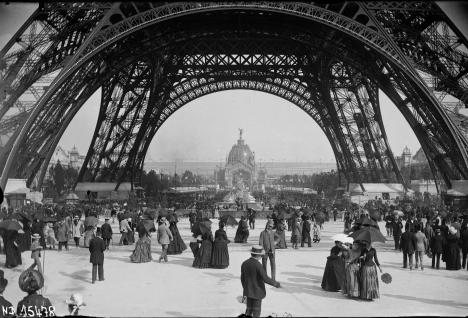

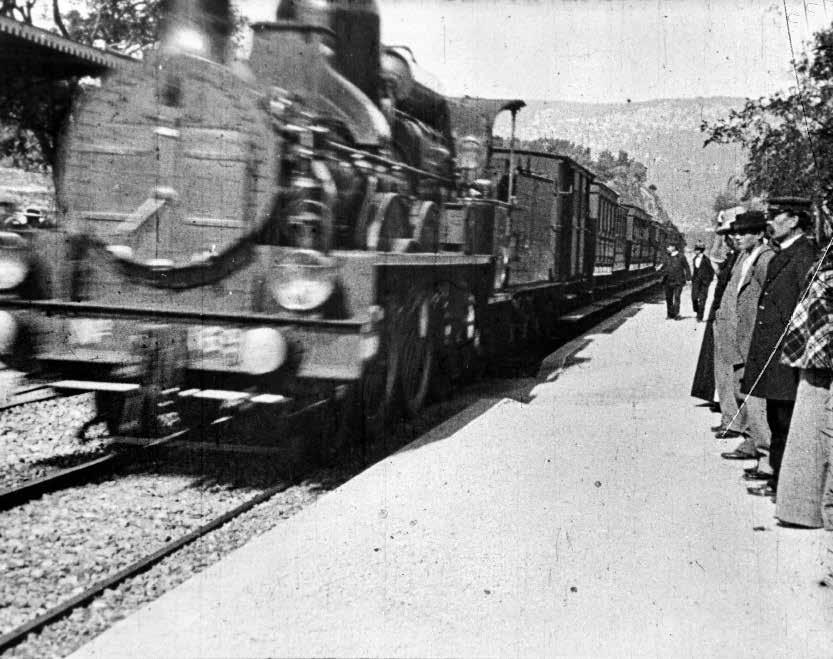
October, 1895 - La Ciotat, France
The Arrival of a Train at La Ciotat Station is one of the first short films of the so-called cinema of origins. This brief, fifty-second documentary about everyday life has greater historical than artistic value. Two French entrepreneurs who specialized in the field of photography made the film: the famous brothers, Auguste and Louis Lumière, patented in 1895 the projector they used for this work (and for many other contemporary works). Because of their invention, the Lumière brothers are known as the fathers of cinema.
This image is a frame from the film and it clearly shows many of its significant qualities: from the angle of the shot, which is not full-on but diagonal, to the depth of the visual field, and from the perfect focus of the people on the platform, to the strong dynamism of the moving train.
In spite of what is commonly believed, the film was not shown on the evening of December 28th in the Salon Indien du Grand Café, on the Boulevard des Capucines in Paris, which is often described as the place where cinema was born. Rather, the film was first shown a few days later, on January 6th. Legend has it that when the audience saw the projection of the approaching train, they were afraid of being run over and ran out of the room.
Apart from these curiosities, The Arrival of a Train offers an important link between photography, the art of the static image, and cinema, the art of the image in movement. The short film is also considered one of the key moments of the Belle Époque, the vibrant period in which the world experienced unprecedented technical progress. The concept of “free time” stems from that moment. That era of optimistic confidence will soon be ended by the trenches of the Great War.
Frame from the short film by Auguste and Louis Lumière
This historic black and white photo, like a classic medium shot from the movies, shows two men surrounded by equipment. They are closely examining what appears to be a strip of paper. It is December, 1901, and the formal style of the photograph – which, although established at the time, was not yet considered an artistic means of expression – gives no hint of the emotion the two protagonists are feeling. This photograph officially documents an experiment that marked a great step forward in scientific progress and opened the way to modern telecommunications.
The young man standing on the left is the Italian scientist and inventor Guglielmo Marconi, who at the time was barely 27 years old. The seated man is his British assistant George Kemp. The two are posing for the first wireless telegraph transmission across the Atlantic, an invention for which Marconi will be awarded the Nobel Prize for Physics in 1909.
To carry out this extraordinary experiment, Marconi had an enormous transmitter built at Poldhu, in Cornwall, with an antenna 425 feet high. Later, with his assistants George Kemp and Percy Paget, he left for the Canadian island of Newfoundland. He had ordered the station at Poldhu to transmit, every day at the same hour, the three dots of the Morse alphabet representing the letter S. He hoped to receive the message in Newfoundland. More than 1,800 miles of ocean separate Cornwall from Newfoundland. The message would have to bounce twice off the ionosphere and propel itself along the curvature of the Earth, which the scientific community of the time considered impossible. Then, against all odds, this happened: the three dots of the Morse code traveled from one continent to the other. The young scientist Guglielmo Marconi succeeded in astounding the world with his discovery.
